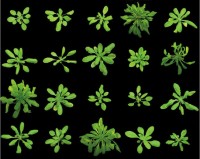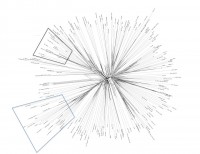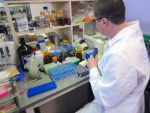What is DNA?
DNA stores information about how to build an organism. Just as a series of 0’s and 1’s represents digital data, DNA data is represented by four letters (A, C, G and T), which inherently allows DNA to store more information per unit (Figure 1).

The amount of DNA required to build a human is mind-boggling. The human genome has 3.2 billion A’s, C’s, G’s, or T’s, (called nucleotides). Cannabis has 820 million nucleotides. This is true for every cell in the organism. The DNA from a single human cell when spread out would stretch six feet long. A cell is not visible to the naked eye, yet it contains a microscopic thread of DNA six feet long! If you put all the DNA molecules in your body end to end, the DNA would reach from the Earth to the Sun.
DNA is common in all living things, and all living things are related through DNA. Humans and plants share 50% of their genes. In humans, 99.9% of the DNA is identical, thus just 0.1% of DNA differences accounts for all of the variation observed in humans. Cannabis, as a species, is more variable with approximately 1% of the DNA being different among strains. DNA is a super efficient and reliable information storage system. However, mistakes (mutations) do occur and while infrequent, these mutations account for all the differences observed within a species and is called natural genetic variation. Variation within the genomes of a species can help the species survive in unfavorable conditions (evolution) and is also the source of differences in traits, which is the material that is required for successful breeding.
Natural Genetic Variation
DNA mutations occur in every generation and these changes will be different in each individual creating natural genetic variation. Mutations (or more accurately referred to as DNA changes) will be inherited by offspring and will persist in the population if the offspring reproduce.

DNA differences maintain diversity in the gene pool, allowing organisms to respond to new environments (migration) or environmental changes (adaptation). The two most commonly described cannabis families are Indicas and Sativas. Indicas, being from cooler temperate regions, have wide leaves allowing the maximum capture of light during the shorter growing season. Sativas, being equatorial, have smaller leaves, which may be an advantage for such things as powdery mildew in a humid environment. Figure 2 shows the enormous amount of natural variation in leaves for one species with a worldwide population (Arabidopsis thaliana).
A DNA change that occurred a long time ago will be more useful to divide people/plants into different groups. For example, there are ancient DNA changes that differentiate humans originating from Europe or Asia. Other newer DNA changes allow us to further divide Europeans into those originating from Northern versus Southern Europe. Thus, different DNA changes have different values for determining relatedness or ancestry, yet every DNA change provides some information for determining heredity.

Family Trees
By comparing DNA changes among different strains, we can measure the relatedness between strains. For example, if strain A has a DNA change indicative of Kush ancestry and strain B has a DNA change indicative of hemp ancestry, we can assign strains to branches of the cannabis family tree comprised of strains that contain similar DNA changes. Figure 3 shows 184 strains that have been characterized for these changes, and the position of each strain is based on its shared DNA with neighboring strains. The two best-defined families of cannabis are hemp (blue) and kush (black). Strains within a family are more closely related. Strains in separate families, such as kush and hemp, are more distantly related.
Editor’s Note: This is the first installment in a series of articles focused on answering common questions regarding cannabis genetics. If you have questions regarding cannabis genetics, or wish to speak more about the topic please post in the comments section below. The next installment will delve into the THC synthase, gene discovery and manipulation and mapping chromosomes.



